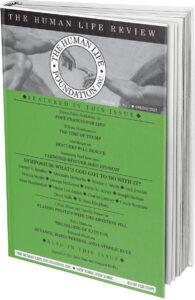Saved by a Flesh and Blood Baby
The article you are reading right now, like any article written by an actual person, is a soon-to-be-obsolete artifact of a passing age. If you use the internet, you have read many things generated by algorithms derived from a combination of pre-determined site objectives and your own ever-evolving user profile. These articles were for a short time easy to detect, for the same reasons that computer-generated voices remain easy to detect. But they are becoming better all the time and, soon enough, no blockhead writer like me will be able to compete.
If you found that paragraph inelegant or muddled or uninteresting, and were to leave this site a fraction of a second after reading it, your ever-evolving profile would make note of that, and tailor-made, algorithm-generated articles in the future would be constructed accordingly. But if you continue on for more than a few seconds, then that will become a data point in the perpetually refining pointillist portrait of you. You are the center of the universe. More than that, you are destined to conclude that there is no universe beyond you. You are in an echo chamber, encapsulated in a bubble-mirror. But of course, your echo, your reflection, is an illusion, and you are not really the sum total of all that is. You are being massaged in ever-more subtle, less detectable ways. You are being shaped by Svengali-like, expressionless titans using algorithms to anticipate your evolving interests and moods with ever-greater precision and swing your attention in desired directions.
The insidious threat of artificial intelligence has been a well-mined vein of science fiction for a long time, and was powerfully illustrated by the 1959 Twilight Zone episode “The Lonely.”
It is 2046, and Corry has been condemned to a life of isolation on a distant asteroid. His only human contact happens for a few minutes every three months with the crew of a spaceship dropping off provisions. The captain of the ship is compassionate, and leaves books and magazines as small consolations. One time he leaves a mysterious box, not to be opened until the ship has left. He tells Corry he’s not sure whether it’s a blessing or a curse.
When Corry opens the box, the contents become animated—it is a captivatingly beautiful woman, who says: “My name is Alicia, what’s your name?” Corry is deeply conflicted. When Alicia tenderly reaches out to him, he pushes her to the ground, bitterly remarking, half to himself, half to the robot woman, that this pile of nuts and bolts is a mockery of his human loneliness. But when he sees Alicia cry, he crosses the uncanny valley. Suspending disbelief, he falls in love.
In a voice-over, Corry muses about how Alicia is developing interests like his, and at times “it’s almost like hearing my own voice.” The truth is, Corry did not fall in love, because Alicia was not an “other.” She was merely a technologically advanced version of the reflection Narcissus saw in the pool. She may have seemed to be the perfect mate, be in fact Alicia was a simulacrum. Simulacra are replicas that so deeply imbed within our consciousness they supplant the originals they represent, even to the point of leaving our real experience of things feeling hollow and unsatisfying. This process is known as derealization.
Witnesses of accidents or violent crimes sometimes report derealization. All of us have a deep mental pool of vicarious experiences of violence and calamity, enhanced by soundtracks, slow-motion, and multiple-angle filming. If we witness these things in real life, we often feel underwhelmed. And this is becoming more so all the time. Watch this video of “hyper-reality,” where the world of flesh-and-blood-being and sensory perception of actual things is merely a backdrop for the more captivating hyper-reality narrative. Or consider the devastating effect that online pornography has had on our capacity for sexual intimacy. In 2007, the year the smartphone hit the market, erectile dysfunction among men under 40 was one percent. Today, ED effects from 31 to 37 percent of men in this age group.
Analgesia is the inability to feel physical pain. It is a very dangerous, even life-threatening condition, because pain alerts the brain to attacks on our physical well-being. But we are not just physical beings; we are intrinsically social. We need the company of others and when we lack sufficient engagement with other people we experience loneliness. As we are increasingly overwhelmed by simulacra, derealization, and hyper-reality, we are becoming less aware of how lonely we really are. We are all being overcome by interpersonal analgesia.
This is a crisis because so much of what is best in us is awakened by and experienced with other people. The philosopher Emmanuel Levinas said “ethics begins in the face of the other.” And at no time is this truer than when we encounter a baby. My family just spent Christmas with our first grandchild, two-month-old Thomas. We are thoroughly modern souls, addicted to our phones and laptops, increasingly disengaged from the people and the world around us, as technology perfects the illusion of non-essential plastic being. But we were captivated by the eyes of baby Thomas. And re-awakened to each other. It makes perfect sense that Our Lord came into the world as a baby.









